- Clone
- 1B11 (See other available formats)
- Regulatory Status
- RUO
- Other Names
- Ly-48, Leukosialin, Sialophorin, Leukocyte Sialoglycoprotein, gp115
- Isotype
- Rat IgG2a, κ
- Ave. Rating
- Submit a Review
- Product Citations
- publications
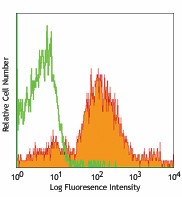
-

C57BL/6 mouse splenocyts stained with 1B11 PE/Cyanine5
| Cat # | Size | Price | Quantity Check Availability | Save | ||
|---|---|---|---|---|---|---|
| 121216 | 100 µg | 244€ | ||||
CD43, also known as Ly-48, Leukosialin, Sialophorin, Leukocyte Sialoglycoprotein, and gp115, is a large single chain of type I transmembrane glycoprotein with abundant O-glycosylation and sialylation sites. Due to variable glycosylation and sialylation, two isoforms of CD43 have been identified. The 115 kD glycoform of CD43 is expressed on most hematopietic cells including T lymphocytes, NK cells, monocytes, granulocytes, platelets, and CD5+ B cells. It is not present on resting B cells and erythrocytes. While the 130 kD glycoform is thought to be activation-associated form primarily expressed on myeloid cells, pre-B cells, and activated T cells. It has been reported that CD43 binds to CD54 and Siglec-1. CD43 plays dual roles in cell adhesion and anti-adhesion, as well as costimulation of T cell activation and survival, and induction of apoptosis of T cells and hematopoietic progenitors. The 1B11 antibody reacts with the activation-associated glycoform of CD43. The epitope recognized by 1B11 is also shared with desialylated CD45RB. This antibody is useful for differentiation of effector CD8 T cells and memory T cells.
Product DetailsProduct Details
- Verified Reactivity
- Mouse
- Antibody Type
- Monoclonal
- Host Species
- Rat
- Immunogen
- Mouse WEHI 274.3 myeloid tumor cells
- Formulation
- Phosphate-buffered solution, pH 7.2, containing 0.09% sodium azide.
- Preparation
- The antibody was purified by affinity chromatography, and conjugated with PE/Cyanine5 under optimal conditions.
- Concentration
- 0.2 mg/ml
- Storage & Handling
- The antibody solution should be stored undiluted between 2°C and 8°C, and protected from prolonged exposure to light. Do not freeze.
- Application
-
FC - Quality tested
- Recommended Usage
-
Each lot of this antibody is quality control tested by immunofluorescent staining with flow cytometric analysis. For flow cytometric staining, the suggested use of this reagent is ≤ 1.0 µg per 106 cells in 100 µl. It is recommended that the reagent be titrated for optimal performance for each application.
- Excitation Laser
-
Blue Laser (488 nm)
Green Laser (532 nm)/Yellow-Green Laser (561 nm)
- Application Notes
-
Additional reported applications (for the relevant formats) include: immunoprecipitation1,2, Western blotting1,2, and immunohistochemistry of acetone-fixed frozen sections.
-
Application References
(PubMed link indicates BioLegend citation) -
- Jones AT, et al. 1994. J. Immunol. 153:3426. (IP, WB)
- Carlow DA, et al. 1999. J. Immunol. 163:1441. (IP, WB)
- Onami TM, et al. 2002. J. Immunol. 168:6022.
- van der Most RG, et al. 2003. Intl. Immunol. 15:119.
- Chu VT, et al. 2007. J. Immunol. 179:5947.
- Lang A, et al. 2008. J. Immunol. 180:4848. PubMed
- Gibbert K, et al. 2010. J. Immunol. 185:6179. PubMed
- Product Citations
-
- RRID
-
AB_528811 (BioLegend Cat. No. 121216)
Antigen Details
- Structure
- Single chain of type I transmembrane glycoprotein with abundant O-glycosylation and sialylation sites, 115 kD and 130 kD glycoforms with different glycosylation and sialylation
- Distribution
-
Most hematopoietic cells including peripheral T cells, NK cells, granulocytes, monocytes, thymocytes, platelets, plasma cells, CD5+ B-1 cells and activated B cells, and hemotopoietic progenitor cells.
- Function
- Play a dual roles in cell-cell adhesion and anti-adhesion, costimulation of cell activation and survival, induce apoptosis of T cells and hematopoietic progenitors
- Ligand/Receptor
- CD54, Siglec-1
- Cell Type
- B cells, Granulocytes, Hematopoietic stem and progenitors, Monocytes, NK cells, Plasma cells, Platelets, T cells, Thymocytes
- Biology Area
- Immunology
- Molecular Family
- Adhesion Molecules, CD Molecules
- Antigen References
-
1. van den Berg TK, et al. 2001. J. Immunol. 166:3637.
2. Moore T, et al. 1994. J. Immunol. 153:4978.
3. Onami TM, et al. 2002. J. Immunol. 168:6022.
4. Tong J, et al. 2004. J. Exp. Med. 199:1277.
5. Jones AT, et al. 1994. J. Immunol. 153:3426. - Gene ID
- 20737 View all products for this Gene ID
- UniProt
- View information about CD43 on UniProt.org
Related FAQs
Other Formats
View All CD43 Reagents Request Custom ConjugationCustomers Also Purchased
Compare Data Across All Formats
This data display is provided for general comparisons between formats.
Your actual data may vary due to variations in samples, target cells, instruments and their settings, staining conditions, and other factors.
If you need assistance with selecting the best format contact our expert technical support team.
-
Purified anti-mouse CD43 Activation-Associated Glycoform

C57BL/6 mouse splenocytes stained with purified 1B11, follow... -
Biotin anti-mouse CD43 Activation-Associated Glycoform
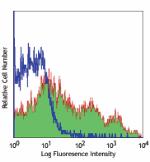
C57BL/6 mouse splenocytes stained with biotinylated 1B11, fo... -
FITC anti-mouse CD43 Activation-Associated Glycoform
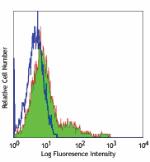
C57BL/6 mouse splenocytes stained with 1B11 FITC -
PE anti-mouse CD43 Activation-Associated Glycoform

C57BL/6 mouse splenocytes stained with 1B11 PE -
Alexa Fluor® 488 anti-mouse CD43 Activation-Associated Glycoform
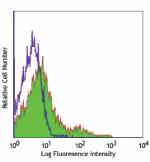
C57BL/6 mouse splenocytes stained with 1B11 Alexa Fluor® 488 -
Alexa Fluor® 647 anti-mouse CD43 Activation-Associated Glycoform

C57BL/6 mouse splenocytes stained with 1B11 Alexa Fluor® 647 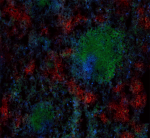
3 Day 4T1 cells induced BALB/c frozen spleen section was fix... -
APC anti-mouse CD43 Activation-Associated Glycoform
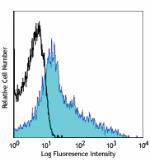
C57BL/6 mouse splenocytes stained with 1B11 APC -
PE/Cyanine5 anti-mouse CD43 Activation-Associated Glycoform

C57BL/6 mouse splenocyts stained with 1B11 PE/Cyanine5 -
PE/Cyanine7 anti-mouse CD43 Activation-Associated Glycoform

C57BL/6 mouse splenocytes stained with 1B11 PE/Cyanine7 -
APC/Cyanine7 anti-mouse CD43 Activation-Associated Glycoform
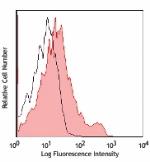
C57BL/6 mouse splenocytes stained with 1B11 APC/Cyanine7 -
PerCP anti-mouse CD43 Activation-Associated Glycoform
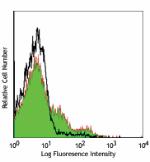
Balb/c mouse splenocytes stained with 1B11 PerCP -
PerCP/Cyanine5.5 anti-mouse CD43 Activation-Associated Glycoform
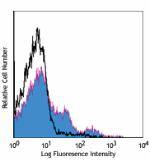
Balb/c mouse splenocytes stained with 1B11 PerCP/Cyanine5.5 -
PE/Dazzle™ 594 anti-mouse CD43 Activation-Associated Glycoform
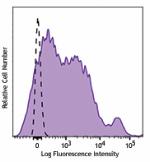
C57BL/6 mouse splenocytes stained with CD43 (clone 1B11) PE/... -
TotalSeq™-B1284 anti-MU CD43 Activation-Associated Glycoform
-
TotalSeq™-C1284 anti-MU CD43 Activation-Associated Glycoform
 Login / Register
Login / Register 










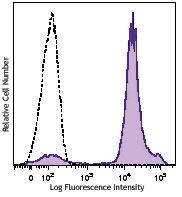
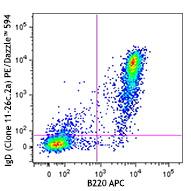
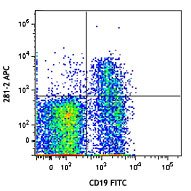
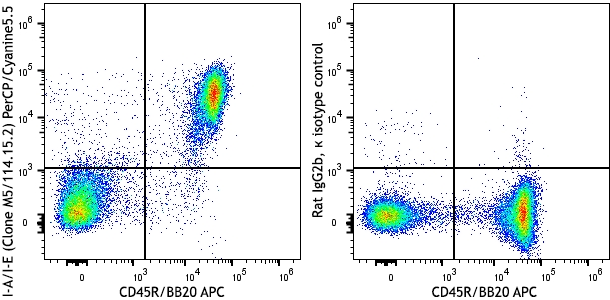



Follow Us